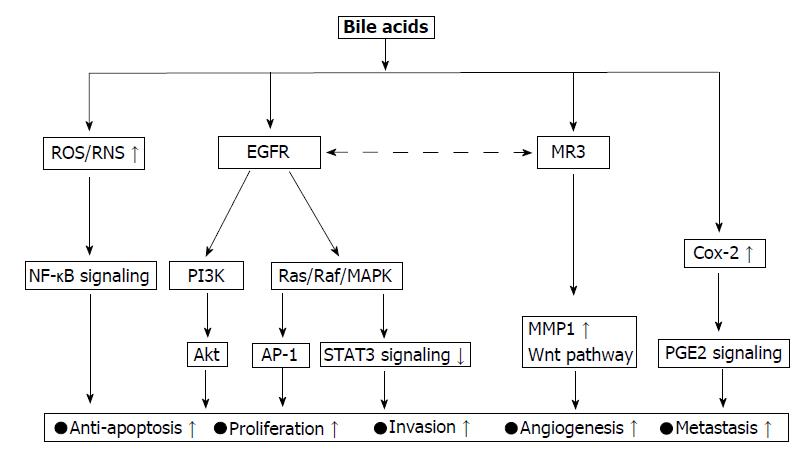Copyright
©The Author(s) 2018.
World J Clin Cases. Nov 6, 2018; 6(13): 577-588
Published online Nov 6, 2018. doi: 10.12998/wjcc.v6.i13.577
Published online Nov 6, 2018. doi: 10.12998/wjcc.v6.i13.577
Figure 3 Oncogenic signaling network activated by bile acids.
The epidermal growth factor receptor (EGFR) pathway is central signaling for bile acid (BA) action associated with colorectal cancer (CRC) progression. Over-activation of this pathway in tumor cells is associated with tumor cell proliferation, survival, angiogenesis, invasion, and metastasis. PI3K and Ras/Raf/MAPK are two dominant downstream signaling cascades of EGFR activation. Muscarinic cholinergic receptor 3 (MR3) is another actor that mainly contribute to CRC initiation and progression mediated by BAs. This action of CR3 requires cross-talk with EGFR transactivation. MR3 activation stimulates MMP1 expression, which promotes CRC invasion and mediates for BA-induced CSCs in the colonic epithelial population via Wnt pathway. NF-κB is also one of major signaling activated by BAs. This signaling is activated by oxidative stress and as downstream of PI3K signaling. It protects cells against apoptosis and enhances cell proliferation. Cox-2/PGE2 is one of the signaling events of BAs action, BAs increase the synthesis of PGE2 via Cox-2 enzyme induction. This signaling increases the expression of Bcl-2, that then suppresses p53-induced apoptosis thereby promoting tumorigenesis. Additionally, PGE2 signaling is known to stimulate cAMP production, which can stimulate tumor growth by suppressing apoptosis. ROS: Reactive oxygen species; RNS: Reactive nitrogen species, NF-κB: Nuclear factor kappa-light-chain-enhancer of activated B cells; PI3K: Phosphatidylinositol-4,5-bisphosphate 3-kinase; EGFR: Epidermal growth factor receptor; MAPK: Mitogen activated protein kinase; AP-1: Activator protein 1; STAT3: Signal transducer and activator of transcription 3; Cox-2: Cyclooxygenase 2; PGE2: Prostaglandin E2; MR3: Muscarinic cholinergic receptor 3.
- Citation: Nguyen TT, Ung TT, Kim NH, Jung YD. Role of bile acids in colon carcinogenesis. World J Clin Cases 2018; 6(13): 577-588
- URL: https://www.wjgnet.com/2307-8960/full/v6/i13/577.htm
- DOI: https://dx.doi.org/10.12998/wjcc.v6.i13.577









